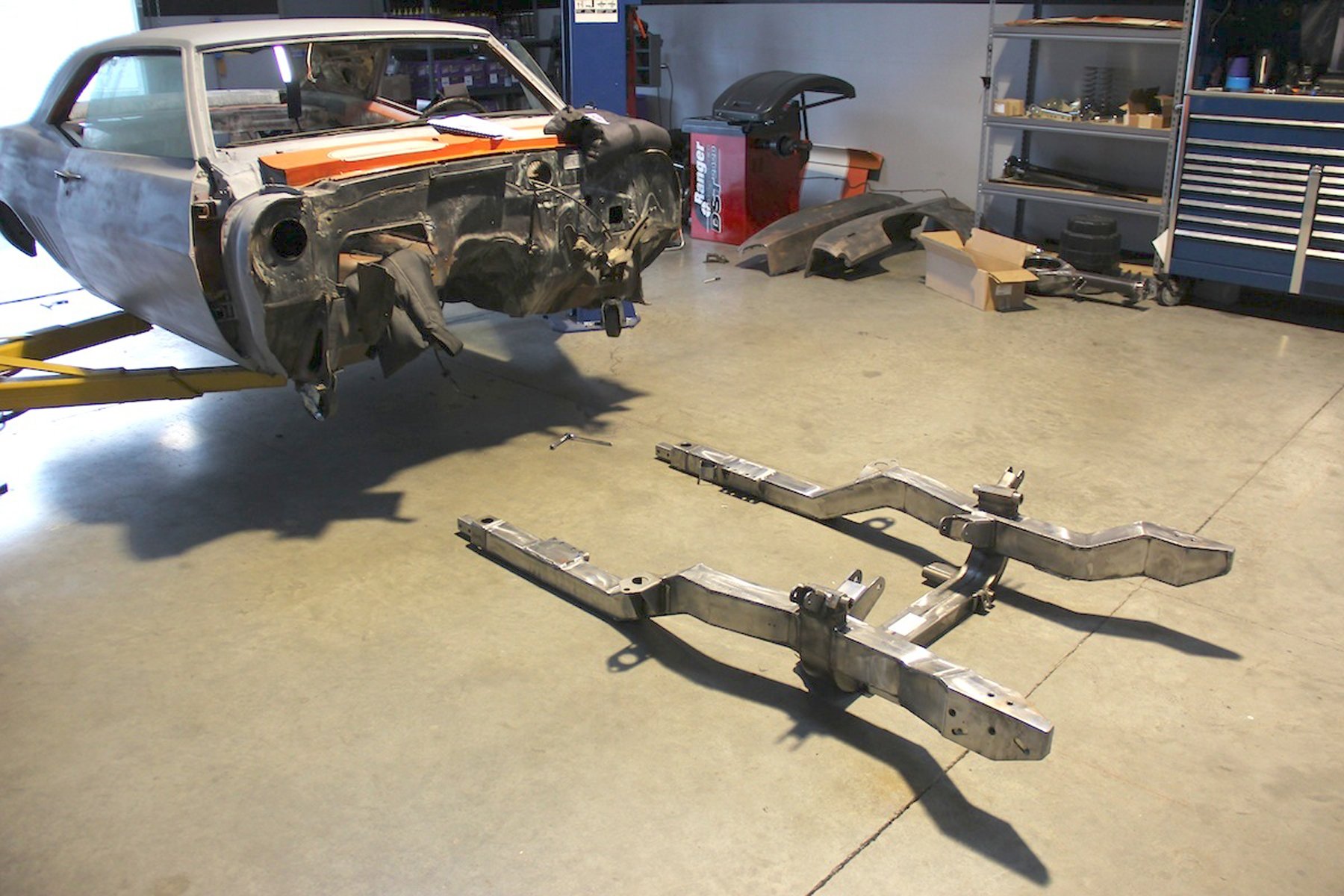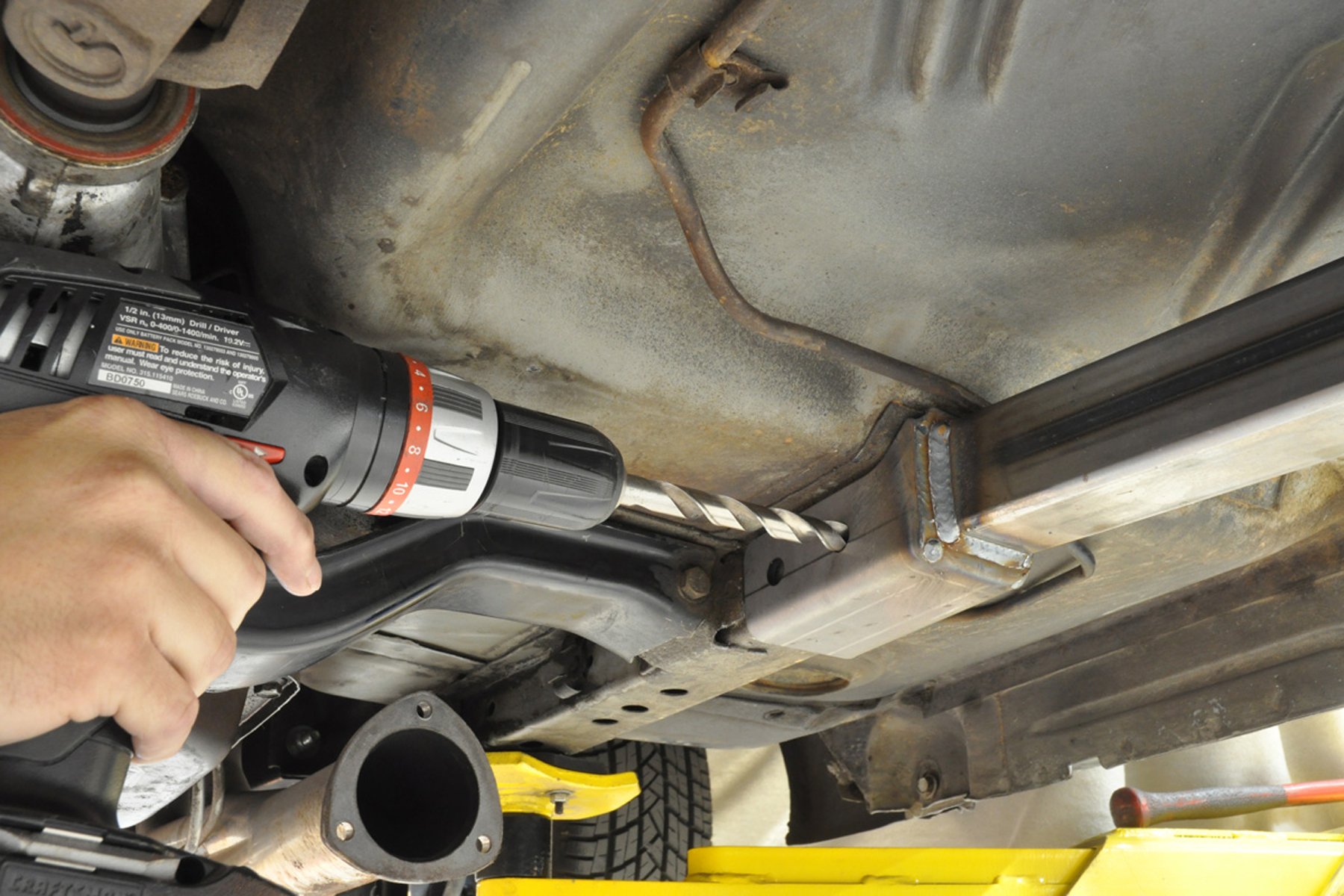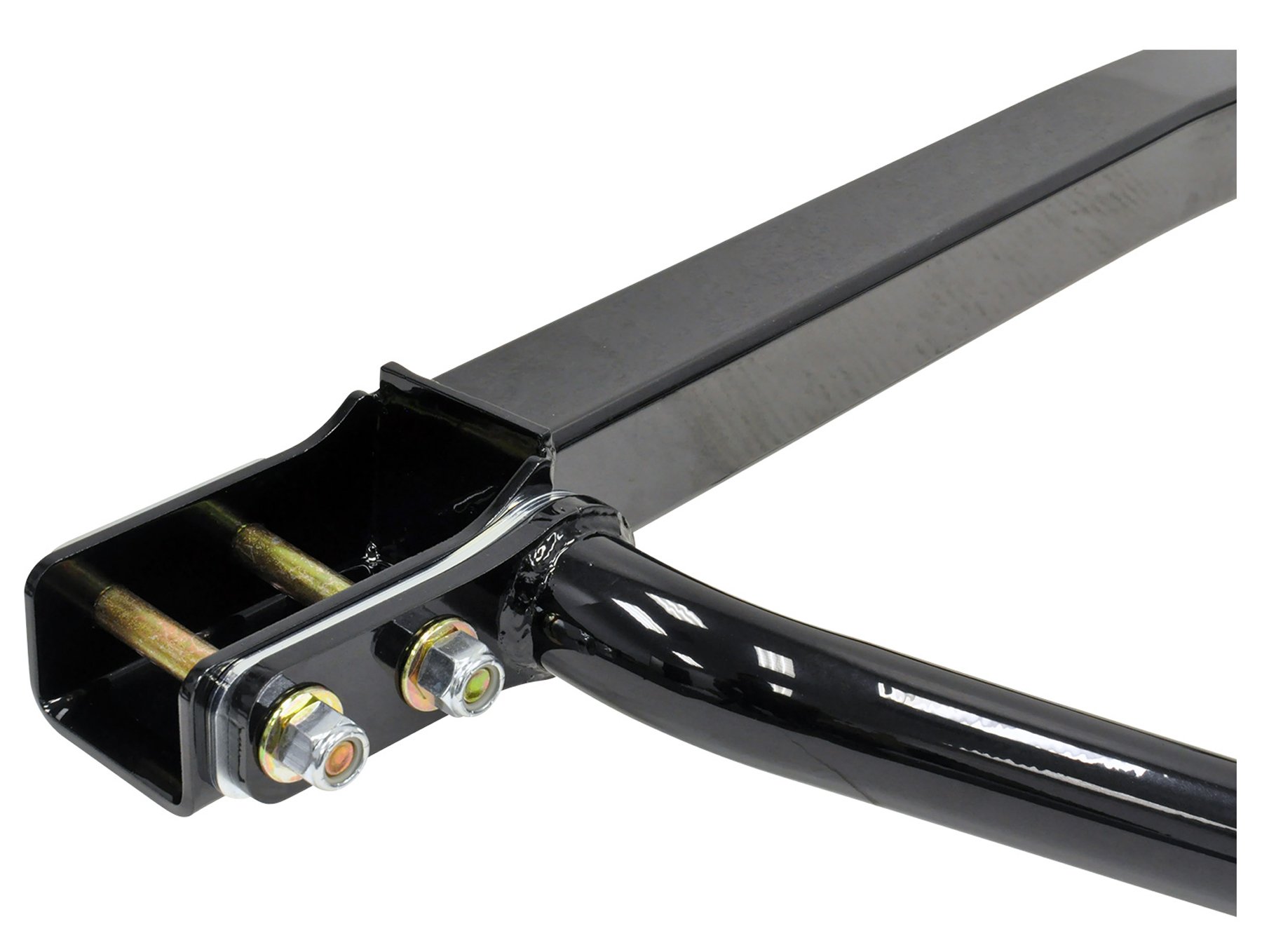If you look back at some of the General’s hottest-performance cars, you will notice a reoccurring theme — many do not have a traditional perimeter frame. Many of these muscle cars were built on what is called a unibody platform. Camaros, Novas, and Firebirds were all built with a unibody construction utilizing a front subframe section that attached to the body, rather than full perimeter frames where the body is mounted onto the frame structure.
This was okay when the cars were new and factory stock. But, age and the addition of a few major performance enhancements, will help you soon notice how inadequate a “seasoned” unibody-constructed car really is when diving into building a true performance classic.
A unibody Camaro, Firebird, or Nova has rear framerails that are integrated into the body (left). The front rails (right) are a bolt-in frame section that attaches to the structure's floor at specific locations. Rigidly connecting these two foundational areas is crucial for a great riding and handling classic. shown is Chassisworks' bolt-in frame section going into a '69 Camaro.
Flexability On Demand
Because a unibody car is lacking a perimeter frame, the body can twist and flex when engine torque is applied to move the car and while simply driving over road irregularities. And after 30- or 40-plus years, that flexing has definitely wreaked havoc on the welded seams and joints. Therefore, adding a set of subframe connectors is an easy and relatively inexpensive way to add support to the body and stiffen up the chassis to deliver a better handling car and help prevent loss of performance.
To explain this reasoning even better, we reached out to Chris Alston Chassisworks to find out why — unless you are installing a completely new chassis — subframe connectors should be your first modification when upgrading your F- or X-body’s suspension.
It is well documented that chassis flex can and will rob performance. So, stiffening your car’s chassis with subframe connectors will provide several benefits like improved handling, better launches, improved ride quality, and even vehicle longevity.
We can say handling is improved because chassis flex will be reduced. This will help keep the car’s suspension loads contained within the springs and shocks, rather than being absorbed by the flexing action of the unibody. When the chassis flexes, it essentially acts as a fifth spring by absorbing the power the engine is applying to move the car. This absorbed power is taken away from where it can do the most good — your suspension.
Stiffening the chassis allows the suspension to more effectively do its job and makes the effects of suspension tuning far more predictable. – Lino Chestang, Chassisworks
Take-off (launching) from a red light or at the drag strip will be exponentially improved, because, again, chassis flex is reduced. Look at it this way, when mashing the throttle pedal, the engine torque will be instantly sent to the rear axle rather than being used up by the flexing of the unibody construction.
Although many do not consider this aspect, ride quality and comfort can also be drastically improved by the reduction in chassis flex. How it works is: the connectors help keep the forces applied by road irregularities contained to the suspension rather than being absorbed, again, by the flexing of the body. Are you noticing how body flex can hinder your car’s performance? Again, controlling body flex means the car is much more supported and controllable. In fact, we once witnessed a small-block-powered Vega pop the windshield out of the car while launching at a drag race.
The car we are showing is an early Nova ('62-'65). In this install, the front cup fits over the end of the front frame rail, and the rear plate seats along the inside of the frame rail just forward of the leaf-spring bolt. The bracket behind the rear mounting area is the lower arm bracket for Chassisworks' g-Link rear suspension. This bracket is not required to install subframe connectors. The holes being drilled through the connectors are for the optional, and recommended, center support.
“In high-performance applications, the flexing of the entire vehicle and its components affects suspension performance,” states Lino Chestang of Chris Alston Chassisworks. “Higher-rate springs, urethane bushings, stiffer shocks, lower-profile tires, all have greater resistance to motion and therefore, transfer more force and movement into the chassis. Stiffening the chassis allows the suspension to more effectively do its job and makes the effects of suspension tuning far more predictable.”
But what about the average cruiser hot rod? Is installing a set of subframe connectors something the average enthusiast should consider? “The benefits of increased chassis stiffness are not limited only to high-performance cars,” says Lino. “Your average street-driven, stock, classic car suffers from general fatigue and wear along many of the chassis seams and contact points. There may be damage or distortion in the rails and panels that compromise the strength of the chassis, which even when new, was not up to modern standards. Most owners have likely seen this firsthand when jacking up their car and the door-jamb gaps widen or the door striker alignment shifts.
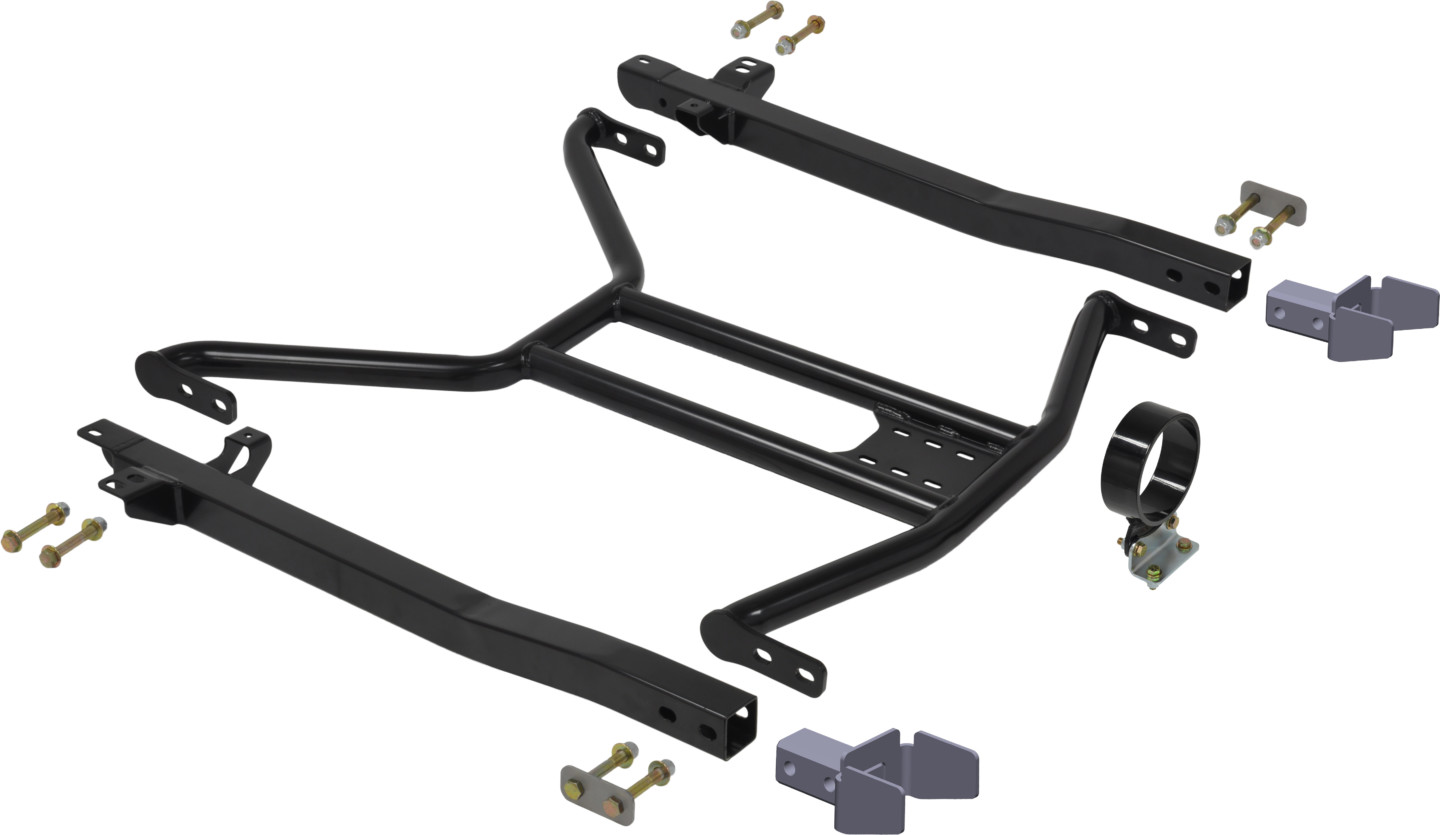
If you’re looking for the ultimate OE-chassis support, the g-Connector system includes subframe connectors, center support, and driveshaft loop. The system fits completely underfloor. According to Chassisworks, there is room available to tightly run a 3-inch dual exhaust. However, it may require custom exhaust installation.
“This bit of bending and flex doesn’t just happen when there is a jack under the car. Speed bumps, potholes, driveways, and rough roads also stress and continually fatigue the chassis. The factory rockers are designed to increase stiffness during such events, but without a direct connection to frame rails, they fall short of being a perfect solution. The most effective aftermarket solution is to create a continuous structure, linking the front and rear frame rails and suspensions.”
Speed bumps, potholes, driveways, and rough roads also stress and continually fatigue the chassis. – Lino Chestang, Chassisworks
With that in mind, it’s easy to see why your car will surely be a better hot rod with frame connectors installed. We have even found cars with fatigue-cracks forming in the exterior metal from the continuous flexing and overstressing of the unibody’s sheetmetal. Without subframe connectors, it is even common for a car’s floor pan to develop cracks. Drag cars often see cracks form in the exterior sheetmetal around the A-pillars. Improper placement of a floor jack when lifting a corner of a car can even distort the floor pan. Have we sufficiently expressed the importance of subframe connectors?
What Are “Subframe Connectors” And Where Do They Go?
Subframe connectors are steel-tube reinforcements that are welded or bolted to the underside of the car. They connect the front and rear subframe rails together. This strengthens the body by “rigidly” connecting the two ends of the car and greatly increases the rigidity of the unibody chassis.
“We feel that all cars — regardless of modification level — should install weld-in subframe connectors,” affirms Lino. “These provide a great improvement and do not require any additional changes to the vehicle — other than possibly relocating the emergency brake cable bracket. However, Chassisworks has a complete subframe g-Connector system, which represents the best value and greatest amount of improvement. This system includes the weld-in connectors, bolt-in center support, and a driveshaft safety loop for the majority of vehicle applications we cover.”
The Chassisworks g-Connector system fits tightly against the underside of the car without the need to notch or cut into the floor structure. The connector ends feature clevises and brackets specifically designed for each vehicle and ensure correct positioning and a stable connection to the factory subframes. We’re told the bolt-in center support not only creates triangulation across the undercarriage, but it also offers enough room below the transmission tunnel to run 3-inch exhaust. It’s tight, but it fits. Once installed, the g-Connector system provides a direct, structural bridge between the rear subframe at the spring mount and the front suspension subframe.
Weld-In vs Bolt-In
There are two styles of subframe connectors. The most trusted among many performance junkies is the weld-in type. When looking into weld-in connectors, there are a few things to keep in mind. Some connectors might require cutting the floorboards, and/or factory rear-subframe rails, depending on the brand and application. Be sure to check before you order.
The center support attaches at the front using bolts that go through the factory subframe. The rear attaches to a mount on each connector. This modular design allows enthusiasts to purchase the g-Connector parts in stages, and allows for easy removal if the transmission needs to come out.
While it might sound like unnecessary work to install connectors under a street car, the end truly does justify the means. This install process will keep the subframe tucked up to the body as tightly as possible, not adding to any ground clearance issues, and yet, improve structural rigidity. Of course, welding is on the agenda too. Though these types of subframes do require a longer install time, it still should not take much longer than a day’s worth of work to wrap it up.
To some, bolt-in connectors are viewed as less effective. However, if installed correctly, these connectors will deliver a benefit to the car. The reason for the stigma is because they are not fully secured to the vehicle’s chassis (i.e. welded). Some feel there’s still room for unwanted flex to occur because welds are not used.
“The subframe-connector attachment to the chassis must be absolutely solid,” says Lino. “In most cases, this requires welding. However, on some vehicles — such as the first- and second-generation Camaro and Firebird — we use the mounting bosses for the forward leaf-spring bracket as the rearward attaching point. This creates a solid foundation, and we can use grade-8 hardware to secure the center support and complete the assembly.”
It’s no surprise that bolt-in connectors are easier to install, will give the vehicle some much-needed support, and are even more affordable in some cases (especially if you must pay someone to weld-in the other type). These factors make it a desirable choice for many.
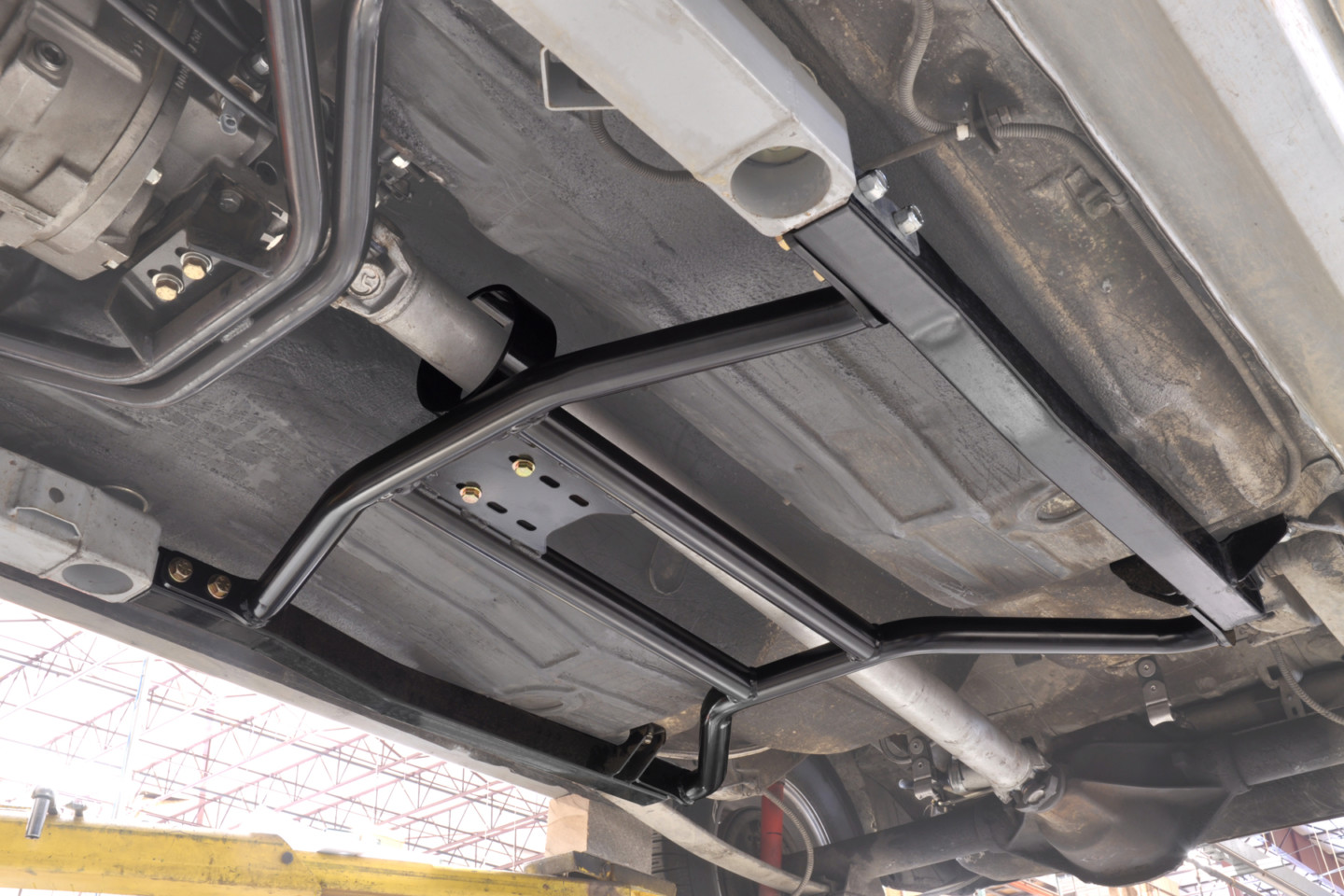
The g-Connector is the Mac-Daddy of subframe connectors. With an integrated driveshaft loop, the system keeps the chassis from flexing, and the driveshaft loop keeps you safe in case of U-joint breakage.
“Many customers are quite surprised at the difference in their car after installing subframe connectors,” states Lino. “There are usually fewer squeaks and rattles, and they notice a more solid feel while driving.”
Overall, a quality subframe-connector system is a simple upgrade that helps to create a better car and a better platform on which to build, no matter what type of fun you are looking to have. If this inexpensive upgrade can make your car great, we think it’s one that should be on everyone’s list to complete.





